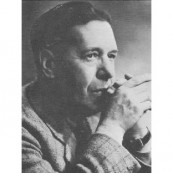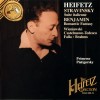传记
Arthur Leslie Benjamin (18 September 1893 – 10 April 1960) was an Australian composer, pianist, conductor and teacher. He is best known as the composer of Jamaican Rhumba, composed in 1938.
Arthur Benjamin was born in Sydney, but at age 3 his parents moved to Brisbane. At the age of six he made his first public appearance as a pianist and his formal musical training began three years later with the Brisbane City organist, George Sampson. In 1911, Benjamin won a scholarship from Brisbane Grammar School to the Royal College of Music (RCM), where he studied composition with Charles Villiers Stanford, harmony and counterpoint with Thomas Dunhill, and piano with Frederick Cliffe.
In 1914 he joined the Officer Training Corps, receiving a temporary commission in April 1915. He served initially in the infantry as 2nd Lieutenant with the 32nd Battalion of the Royal Fusiliers and in November 1917 he was attached to the Royal Flying Corps. On 31 July 1918 his aircraft was shot down over Germany by the young Hermann Göring, and he spent the remainder of the war as a German prisoner of war at Ruhleben camp near Berlin. There he met the composer Edgar Bainton, who had been interned since 1914, and who was later to become Director of the New South Wales State Conservatorium of Music.
The manuscript of the unpublished Violin Sonata in E minor bears the date 1918, the only surviving work of that year and one of very few to be written by Benjamin during the war.
He returned to Australia in 1919 and became piano professor at the NSW State Conservatorium of Music, Sydney. He returned to England in 1921 to become piano professor at the RCM. Following his appointment in 1926 to a professorship which he held for the next thirteen years at the RCM, Benjamin developed a distinguished career as a piano teacher. His better-known students from that era include Muir Mathieson, Peggy Glanville-Hicks, Miriam Hyde, Joan Trimble, Stanley Bate, Bernard Stevens, Lamar Crowson, Alun Hoddinott, Dorian Le Gallienne, Natasha Litvin (later Stephen Spender's wife and a prominent concert pianist), William Blezard and Benjamin Britten, whose Holiday Diary suite for solo piano is dedicated to Benjamin and mimics many of his teacher’s mannerisms.
He continued writing chamber works for the next few years – Three Pieces for violin and piano (1919–24); Three Impressions (voice and string quartet, 1919); Five Pieces for Cello (1923); Pastoral Fantasy (string quartet, 1924), which won a Carnegie Award that year; Sonatina (violin and piano, 1924).
Orchestral works became more common after 1927 — Rhapsody on Negro Themes (MS 1919); Concertino for piano and orchestra (1926/7); Light Music Suite (1928); Overture to an Italian Comedy (1937); Cotillon Suite (1938). There also appeared over twenty meticulously crafted songs and choral settings.
He was also an adjudicator and examiner for the Associated Board of the Royal Schools of Music, which led him to places such as Australia, Canada and the West Indies. It was in the West Indies that he discovered the native tune on which he based his best-known piece, Jamaican Rhumba, one of Two Jamaican Pieces, composed in 1938, for which the Jamaican government gave him a free barrel of rum a year as thanks for making their country known.
The Violin Concerto of 1932 was premiered by Antonio Brosa with Benjamin conducting the BBC Symphony Orchestra. In 1935 he accompanied the 10-year old Canadian cellist Lorne Munroe on a concert tour of Europe. Three years later he wrote a Sonatina for Munroe, who later became the principal cellist with the Philadelphia Orchestra and the New York Philharmonic, and also recorded the piece.
His Romantic Fantasy for Violin, Viola and Orchestra was premiered by Eda Kersey and Bernard Shore in 1938, under the composer. Its first recording was by Jascha Heifetz and William Primrose.
He resigned from his post at the RCM and left to settle in Vancouver, Canada, where he remained for the duration of the war. In 1941 he was appointed conductor of the newly-formed Canadian Broadcasting Corporation (CBC) Symphony Orchestra, holding the post until 1946. During this time he gave “literally hundreds” of Canadian first performances. After a series of radio talks and concerts in addition to music teaching, conducting and composing, he became a major figure in Canadian musical life. He frequently visited the United States, broadcasting and arranging many performances of contemporary British music. He was also Resident Lecturer at Reed College, Portland, Oregon between 1944 and 1945.
Almost unknown today, Arthur Benjamin's Symphony was given its British premiere at the Cheltenham Festival in July 1948 by Sir John Barbirolli and the Hallé Orchestra. Further performances by the same artists took place in Manchester, Liverpool and the Royal Albert Hall in London the following year. After one more performance by the BBC Symphony Orchestra in August 1954, conducted by the composer, the work appears to have been utterly neglected until it was recorded in recent times by the Queensland Symphony Orchestra, conducted by Christopher Lyndon Gee.
The other major work of the period was the Sonata for Viola and Piano of 1942, also known as Elegy, Waltz and Toccata and bearing the dedication "Written for and dedicated to William Primrose". Benjamin simultaneously prepared the work as a Concerto for Viola and Orchestra, which was given its premiere by Frederick Riddle and the Hallé Orchestra on 30 June 1948, again conducted by Barbirolli. Riddle later recorded the work in its sonata version with the pianist Wilfred Parry for the BBC. Both the Sonata and the Symphony reflect not just the sombre mood of the times but also the darker territory that Benjamin had begun to explore.
Other orchestral and concertante works written in Canada were the Sonatina (1940), Ballade (1944), Suite for Flute and Strings (1945), Prelude to Holiday (1941), Red River Jig (1945), the orchestral setting of the Two Jamaican Pieces (1942), From San Domingo (1945), Caribbean Dance (1946) and two Mendelssohn transcriptions: Præludium and Prelude and Fugue (1941). The Oboe Concerto on themes of Cimarosa (1942) was an orchestration of harpsichord pieces by Domenico Cimarosa; for many years it was frequently mis-labelled as "Cimarosa's Oboe Concerto, arranged by Arthur Benjamin".
The Elegiac Mazurka of 1941 was commissioned as part of the memorial volume 'Homage to Paderewski’ in honour of the Polish pianist who had died that year. In 1945 a shortened piano solo arrangement of the Jamaican Rhumba was published.
Returning to England in 1946, he resumed teaching at the RCM. In 1949, Benjamin wrote his piano concerto Concerto quasi una Fantasia. The concerto, written to a commission from the Australian Broadcasting Commission, served as the solo vehicle for Benjamin's Australian concert tour of 1950 and was premiered by him on 5 September 1950 with Eugene Goossens and the Sydney Symphony Orchestra. It was repeated in a further seven Australian cities. These were Benjamin's final performances as a pianist.
The other major original works written during the 1950s were the Harmonica Concerto (1953), written for Larry Adler, who performed it many times and recorded it at least twice; the ballet Orlando’s Silver Wedding (1951), Tombeau de Ravel for clarinet and piano, a second string quartet (1959) and the Wind Quintet (1960). He had a lasting admiration for Maurice Ravel, whose influence is most obvious in Tombeau de Ravel and the much earlier Suite of 1926 for piano solo.
He was honoured by the Worshipful Company of Musicians by the award of the Cobbett Medal later that year (1957).
His private students included John Carmichael.
Arthur Benjamin died on 10 April 1960, at the age of 66, at the Middlesex Hospital, London, from a re-occurrence of the cancer that had first attacked him three years earlier. An alternative explanation of the immediate cause of death is hepatitis, contracted while Benjamin and his partner, Jack Henderson, a Canadian who worked in the music publishing business, were holidaying with the Australian painter Donald Friend in Ceylon (now Sri Lanka).
Benjamin wrote four operas. The one-act opera The Devil Take Her, to a libretto by Alan Collard and John B. Gordon, was first produced at the RCM on 1 December 1931, conducted by Sir Thomas Beecham. Another one-acter, Prima Donna (1932) had to wait until 23 February 1949 for its premiere, at the Fortune Theatre in London. Its libretto was by Cedric Cliffe, son of Benjamin's piano teacher at the RCM Frederic Cliffe. Both these works met with critical success.
A Tale of Two Cities (1950), and Mañana were full-length operas. The librettist for the former was again Cedric Cliffe. First produced by Dennis Arundell during the Festival of Britain in 1951, it won a gold medal and was later broadcast in a live performance by BBC Radio 3 on 17 April 1953. After this performance, Benjamin revised the piece into its final version. The opera was successfully produced in this form in San Francisco in April 1960, only days before his death. Mañana was commissioned in 1955 and produced by BBC television on 1 February 1956. Unfortunately, it was judged a flop at the time and never revived.
A fifth opera, Tartuffe, with a libretto by Cedric Cliffe based on Molière, was unfinished at Benjamin's death. The scoring was completed by the composer Alan Boustead and the work produced by the New Opera Company at Sadler’s Wells on 30 November 1964, conducted by Boustead. This appears to have been this opera’s only performance.
Benjamin was equally active as a writer of music for films, beginning in 1934 with The Scarlet Pimpernel, an adaptation of music from the Napoleonic era, and Alfred Hitchcock’s The Man Who Knew Too Much (1934, remade 1956), for which Benjamin composed the extended Storm Clouds Cantata. Other scores included those for Alexander Korda's 1947 film of An Ideal Husband, The Conquest of Everest, The Cumberland Story (1947), Steps of the Ballet (British Council/Central Office of Information 1948), The Crowthers of Bankdam (Holbein Films 1947), Above Us the Waves (1955) and Fire Down Below (1957/60). While most of his music scores are archived in the British Library, his film scores are completely lost. Apart from the Boosey & Hawkes edition of An Ideal Husband the only surviving score is the Storm Clouds Cantata.
Herbert Howells wrote an orchestral suite The Bs, in five movements, each celebrating a close friend. The work was first performed in 1914, and ends with an heraldic march movement entitled "Benjee", saluting Arthur Benjamin, who the previous year had given the premiere of Howells' Piano Concerto No. 1. Howells' orchestral piece Procession (written for the 1922 Proms) is dedicated to Benjamin. Benjamin, in turn, later dedicated the three-page Saxophone Blues (1929) to Howells.
The Australian pianist and composer Ian Munro, who has a special affinity with Arthur Benjamin and has recorded many of his piano works, has written a small biography of Benjamin. The first major biography of Arthur Benjamin has been written by Wendy Hiscocks as her doctoral thesis at the Australian National University, and will be published in 2010 to commemorate the 50th anniversary of his death.







![The Heifetz Collection, Volume 19 [2 CD]](http://static.classicalm.com/repository/disk-cover/small/947-img1317413695600051.jpg)
